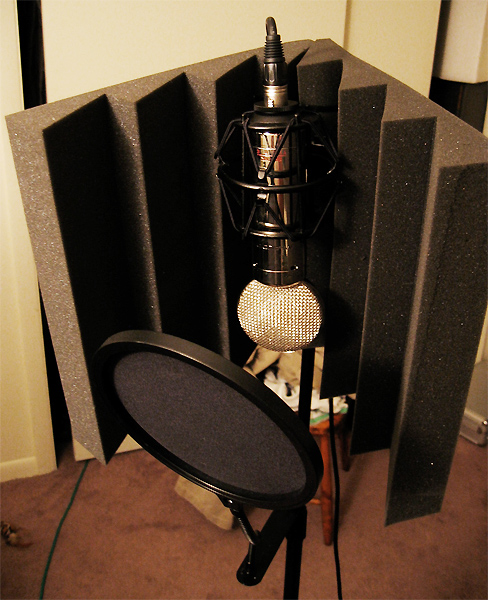In a microphone shoot-out that I did a few years ago between the Shure SM7B and SM58, I discussed some of the reasons for using a dynamic microphone for lead vocals as opposed to a condenser.
One of the main reasons is that dynamics tend to pick up less of the room, so if you have a noisy room or just an acoustically bad-sounding room, a dynamic mic might allow you to still record a decent vocal.
That said, sometimes a condenser microphone simply sounds better.
The next obvious step would be to do everything you can to minimize the amount of room the microphone picks up. The first thing people usually try is to throw the vocalist and microphone into a nearby closet. Problem solved, right? No more room!
Eh…this will usually introduce more problems than solutions. One of the main problems with most home studio rooms is that they are rectangular, chock full of right angles, corners, and parallel surfaces, which cause all sorts of room nodes, standing waves, bass build-up, etc.
Putting the microphone into a smaller rectangle (i.e., a closet) only really brings the microphone closer to all those parallel surfaces and corners. You may think that all your flannel shirts and fur coats will absorb all of those issues, but just like acoustic foam, these materials won’t touch any of the low-frequency problems.
While being in a closet MAY drown out some of the computer/hard drive noise, you’ll most likely end up with a boomy, lifeless vocal.
As always, give it a shot and hear for yourself. You may get the perfect vocal sound in your closet…but I doubt it.
Some Options
In case you’re wondering, I certainly don’t have a perfect room. I tend to pick up a lot of computer, hard drive, traffic, A/C, and neighbor noise when I record.
A few weeks ago, I thought I’d try something. I’m rather familiar with Auralex Aural Xpanders, which are little pieces of foam designed to block out unwanted bleed from the microphone.
And I’m also familiar with the SE Electronics Reflexion Filter, which is a beast of a contraption that surrounds the microphone, providing some good isolation. I’ve actually heard A/B samples of the Reflexion Filter in action, and it’s quite impressive.
However, I’d rather not spend $300 on the Reflexion Filter, at least not without attempting to remedy the situation myself first.
I turned to some leftover Auralex foam I had lying around. Last year I bought a box of the DST-114 panels to treat the area around the mix position in my studio, and I had a few pieces leftover, so I decided to make my own little reflection filter.
As you can see from the picture at right, the two foam pieces placed together make a “V” shape, which surrounds a microphone rather well. I just grabbed a few pull-ties and jammed ‘em through the grooves and tied the foam together.
From here I just feed the foam over the mic and let it “hang” behind the microphone.
So…how well does it work?






















